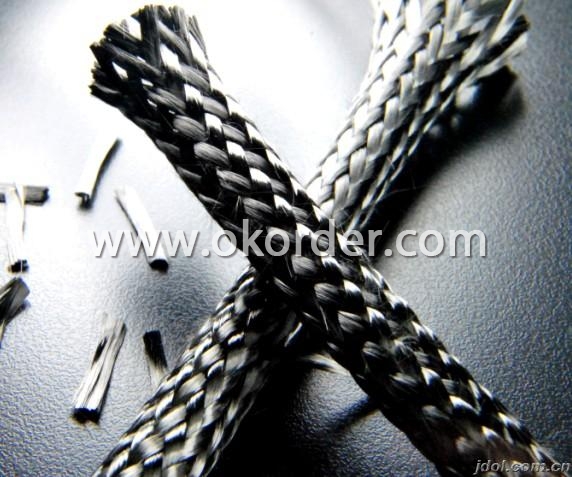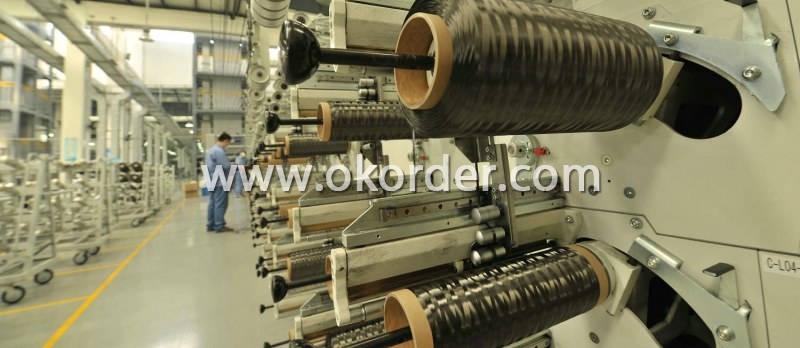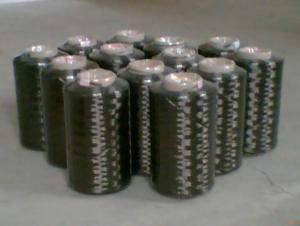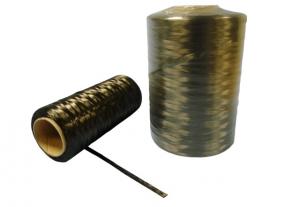Carbon Fiber 12K
- Loading Port:
- China Main Port
- Payment Terms:
- TT or LC
- Min Order Qty:
- 2Ton m.t.
- Supply Capability:
- 1000Ton m.t./month
OKorder Service Pledge
OKorder Financial Service
You Might Also Like
Specifications of Carbon Fiber 12K
1. Material: carbonized polyacrylonitrile fiber
2. Filament number:12k
3. Fiber type: T700
4. Tensile strength: 360kgf/mm2
General Data of Carbon Fiber 12K
|
Tow Size |
Tow Count/CM |
Weave Style |
WidthRange (mm) |
Std. Width (mm) |
Thickness (mm) |
FAW (g/sq.m) |
FAW (oz/sq.yd) |
|
3K |
4 x 4 |
Plain |
10~1500 |
1000 |
0.16 |
160 |
4.72 |
|
3K |
4 x 4 |
2x2 Twill |
10~1500 |
1000 |
0.16 |
160 |
4.72 |
|
3K |
5 x 4 |
Plain |
10~1500 |
1000 |
0.18 |
180 |
5.31 |
|
3K |
5 x 4 |
2x2 Twill |
10~1500 |
1000 |
0.18 |
180 |
5.31 |
|
3K |
5 x 5 |
Plain |
10~1500 |
1000 |
0.2 |
200 |
5.90 |
|
3K |
5 x 5 |
2x2 Twill |
10~1500 |
1000 |
0.2 |
200 |
5.90 |
|
3K |
5 x 6 |
Plain |
10~1500 |
1000 |
0.22 |
220 |
6.49 |
|
3K |
5 x 6 |
2x2 Twill |
10~1500 |
1000 |
0.22 |
220 |
6.49 |
|
3K |
6 x 6 |
Plain |
10~1500 |
1000 |
0.24 |
240 |
7.08 |
|
3K |
6 x 6 |
2x2 Twill |
10~1500 |
1000 |
0.24 |
240 |
7.08 |
|
3K |
8 x 8 |
Plain |
10~1500 |
1000 |
0.32 |
320 |
9.44 |
|
3K |
8 x 8 |
2x2 Twill |
10~1500 |
1000 |
0.32 |
320 |
9.44 |
|
3K |
8 x 8 |
8H Satin |
10~1500 |
1000 |
0.32 |
320 |
9.44 |
Storage of Carbon Fiber 12K
It is recommended that the carbon fiber fabric are stored in a cool and dry environment. Recommended temperature range of storage is between 10 ~ 30 degree and relative humidity between 50 ~ 75%.The carbon fiber fabric should remain in the packaging until just prior to use.
Packaging & Delivery of Carbon Fiber 12K
Product is manufactured in form of a roll wound on a paper tube and then packed in a plastic film and placed within a cardboard carton. Rolls can be loaded into a container directly or on pallets.
Packaging Detail: carton
Delivery Detail: within 20 days


- Q:How does carbon dioxide affect waste management processes?
- The impact of carbon dioxide on waste management processes is significant. One way it influences waste management is through the decomposition of organic waste. When organic waste, such as food scraps or yard waste, is sent to landfills, it decomposes without oxygen, resulting in the production of methane. Methane is a powerful greenhouse gas that contributes to climate change, being approximately 25 times more effective at trapping heat in the atmosphere than carbon dioxide over a 100-year period. Thus, the presence of carbon dioxide indirectly leads to increased methane emissions, exacerbating the greenhouse effect. Additionally, carbon dioxide emissions can occur during waste management activities like transportation and disposal. Vehicles that run on fossil fuels are used to collect and transport waste to landfills or incineration facilities, releasing carbon dioxide into the atmosphere. Furthermore, the incineration process itself produces carbon dioxide as a byproduct. To mitigate the impact of carbon dioxide on waste management, several strategies can be employed. Firstly, efforts to reduce waste and recycle can decrease the need for landfilling or incineration, consequently reducing carbon dioxide emissions. Moreover, implementing waste-to-energy technologies, such as anaerobic digestion or landfill gas capture, can harness the energy potential of organic waste while reducing methane emissions. Anaerobic digestion converts organic waste into biogas, which can be used for electricity or heat generation. Landfill gas capture systems collect methane emitted from landfills and repurpose it for energy production. Lastly, transitioning to low-carbon transportation options, like electric or hybrid vehicles, for waste collection and transportation can help decrease carbon dioxide emissions associated with waste management processes. In conclusion, carbon dioxide impacts waste management by contributing to methane production during organic waste decomposition and by generating emissions during waste transportation and disposal. By implementing waste reduction strategies, waste-to-energy technologies, and transitioning to low-carbon transportation options, the impact of carbon dioxide on waste management can be minimized, resulting in more sustainable and environmentally friendly waste management practices.
- Q:What are the effects of carbon emissions on the stability of desertification?
- Desertification is significantly impacted by carbon emissions, which arise from human activities such as burning fossil fuels and deforestation, releasing carbon dioxide and other greenhouse gases into the atmosphere. These emissions contribute to the global warming phenomenon, which in turn leads to various adverse effects on desertification. One major consequence of carbon emissions is the alteration of precipitation patterns. As the planet warms, the evaporation rate rises, causing more moisture to be held in the atmosphere. Consequently, there is reduced rainfall in numerous regions, particularly in arid and semi-arid areas that are already prone to desertification. The scarcity of water exacerbates the dry conditions, thereby facilitating and intensifying desertification. Additionally, the higher temperatures resulting from carbon emissions contribute to the acceleration of soil erosion. As the land heats up, it becomes more susceptible to erosion caused by wind and water. This erosion leads to the loss of topsoil, which is vital for plant growth and stability. Without a stable layer of topsoil, vegetation struggles to establish and survive, ultimately causing the expansion of deserts. Furthermore, carbon emissions also impact plant communities' health and productivity. While increased levels of carbon dioxide can stimulate plant growth in certain cases, it often results in the proliferation of invasive species that are better adapted to the changing conditions. These invasive species outcompete native plants, diminishing biodiversity and further destabilizing the ecosystem. Additionally, as desertification progresses, the loss of plant cover reduces the capacity to sequester carbon, leading to even higher carbon dioxide levels in the atmosphere. In conclusion, carbon emissions have detrimental effects on desertification's stability. They disrupt precipitation patterns, accelerate soil erosion, reduce plant productivity, and diminish the capacity to sequester carbon. To mitigate these impacts and prevent further progression of desertification, it is crucial to reduce carbon emissions through sustainable practices and conservation efforts.
- Q:Yes, I have a weapon, want to strengthen 11, said to be advanced furnace rock carbon, do not know how to get, look at the prawns pointing
- Pro, tell you an unfortunate news, out of the eighty furnace rock carbon, old horse recycling, burning their own boilers, and now we strengthen the use of colorless small crystal block, that is, the colorless small crystal block instead of the original furnace rock carbon.
- Q:What is carbon emission and what harm does it do? How can carbon dioxide be prevented?
- Carbon deposition reaction:CH4 = kJ/mol C+H274.92CO = CO2+C +172.4 kJ/mol on.The main cause of carbon analysis is that the ratio of water to carbon is too low, so that the rate of carbon removal is lower than the rate of carbon depositionThe above chemical reactions are reversible reaction, from the analysis of thermodynamics, if the increase in temperature or reducing system pressure, increase the possibility of methane decomposition reaction type is CH4 C+H2 produce coke; possibility of CO reaction 2CO = CO2+C and CO = C + H2 reaction +H2O produce coke decrease. If the temperature is reduced or increased the pressure is on the contrary. The effect of temperature on coke reaction is very large, to avoid the [wiki] [/wiki] carbon catalyst must select the appropriate temperature, avoid carbon deposition area.
- Q:How can carbon capture and storage be implemented?
- Carbon capture and storage (CCS) is a technology that involves capturing carbon dioxide (CO2) emissions from industrial processes and storing them underground, preventing their release into the atmosphere. Implementing CCS involves several key steps. Firstly, the capture process involves capturing CO2 emissions from power plants, factories, and other industrial sources. This can be achieved through various methods, such as pre-combustion capture, post-combustion capture, and oxy-fuel combustion. Pre-combustion capture involves converting fossil fuels into a mixture of hydrogen and CO2, with the latter separated and stored. Post-combustion capture involves removing CO2 from the flue gases after combustion. Oxy-fuel combustion involves burning fossil fuels in pure oxygen, resulting in a flue gas that is mostly CO2. Once captured, the second step is transportation. The captured CO2 needs to be transported from the capture site to a storage site. This transportation can be done through pipelines, ships, or trucks, depending on the distance and volume of CO2. Pipelines are the most common method, especially for large-scale projects, as they are cost-effective and efficient. The third step is storage, which involves injecting the captured CO2 deep underground into geological formations for long-term storage. The most suitable storage sites are depleted oil and gas fields, saline aquifers, and deep coal seams. These sites have the capacity to securely store large amounts of CO2 for hundreds or even thousands of years. To ensure the safety and effectiveness of CCS, monitoring and verification play a crucial role. Continuous monitoring is required to detect any potential leaks or seismic activities that may compromise the integrity of the storage site. Verification activities involve assessing the long-term storage of CO2 and ensuring compliance with regulations and standards. Implementing CCS also requires policy support and financial incentives. Governments can provide regulatory frameworks, tax incentives, and funding to encourage the adoption of CCS technologies. International cooperation and collaboration are also important, as CCS can be a global solution to mitigate climate change. In conclusion, implementing carbon capture and storage involves capturing CO2 emissions, transporting them to a storage site, injecting them underground, and monitoring the storage process. It requires various technologies, infrastructure, and policy support to achieve widespread adoption. By effectively implementing CCS, we can significantly reduce greenhouse gas emissions and combat climate change.
- Q:How does carbon impact the productivity of marine ecosystems?
- Carbon impacts the productivity of marine ecosystems in several ways. One of the main ways is through ocean acidification. When carbon dioxide from human activities is released into the atmosphere, a significant portion of it gets absorbed by the oceans. This excess carbon dioxide reacts with seawater to form carbonic acid, leading to a decrease in the pH of the ocean. This increase in acidity has detrimental effects on many marine organisms, especially those that rely on calcium carbonate to build their shells or skeletons, such as corals, shellfish, and some plankton species. Ocean acidification inhibits the process of calcification, making it difficult for these organisms to develop and maintain their protective structures. This not only affects their survival but also impacts the entire food chain. Many species rely on these calcium carbonate structures as a food source or for shelter, so a decline in their productivity can have cascading effects on the ecosystem. Additionally, increased carbon dioxide levels in the ocean can also affect the metabolism and physiology of marine organisms. Some studies have found that elevated CO2 concentrations can impair the growth, development, and reproductive success of certain species. This can lead to a decrease in overall productivity within the ecosystem. Furthermore, climate change, driven by the accumulation of carbon dioxide in the atmosphere, also impacts marine ecosystems. Rising temperatures can disrupt the delicate balance of marine ecosystems, affecting the distribution and abundance of species, altering predator-prey relationships, and leading to changes in the timing of vital ecological events such as spawning or migration. These changes can have profound impacts on the productivity of marine ecosystems, as different species may struggle to adapt or compete under new conditions. In conclusion, carbon dioxide emissions have far-reaching consequences for marine ecosystems. Ocean acidification and climate change, driven by excessive carbon dioxide, have detrimental effects on the productivity of marine ecosystems, affecting the growth, survival, and reproductive success of marine organisms. The impacts of carbon on marine ecosystems highlight the urgent need to reduce greenhouse gas emissions and mitigate the effects of climate change to protect these fragile and vital ecosystems.
- Q:What are the benefits of carbon-neutral technologies?
- Carbon-neutral technologies have numerous benefits, including the reduction of greenhouse gas emissions, mitigating climate change, and improving air quality. They also promote energy efficiency, stimulate innovation and job creation in the clean energy sector, and enhance energy security by reducing reliance on fossil fuels. Furthermore, carbon-neutral technologies contribute to sustainable development, foster international cooperation, and create a healthier and more sustainable future for all.
- Q:What is the primary source of carbon monoxide in the atmosphere?
- The incomplete combustion of fossil fuels stands as the main contributor to carbon monoxide found in the atmosphere. Whenever coal, oil, or natural gas is burned for energy generation, transportation purposes, or industrial procedures, carbon monoxide is inevitably discharged into the air. Despite natural sources like volcanic eruptions and forest fires having the potential to augment the presence of carbon monoxide in the atmosphere, the majority of emissions can be firmly linked to human activities. As a result, addressing carbon monoxide is crucial in safeguarding both human health and the environment.
- Q:What are the environmental impacts of carbon emissions?
- The environmental impacts of carbon emissions include climate change, air pollution, ocean acidification, and ecosystem disruptions. Carbon emissions contribute to the greenhouse effect, leading to global warming and climate change. This results in more frequent and intense extreme weather events such as hurricanes, droughts, and heatwaves. Additionally, carbon emissions contribute to air pollution, especially in urban areas, leading to respiratory problems and other health issues. Increased carbon dioxide in the atmosphere also leads to ocean acidification, threatening marine life and coral reefs. Finally, carbon emissions disrupt ecosystems by altering the natural balance of carbon cycles and causing habitat loss for many species.
- Q:How does carbon dioxide affect the formation of clouds?
- Cloud formation is significantly influenced by carbon dioxide in Earth's climate system. This is because carbon dioxide acts as a greenhouse gas, trapping heat in the atmosphere and causing a global increase in temperatures. This rise in temperature affects various atmospheric processes, including the formation of clouds. One of the main ways carbon dioxide impacts cloud formation is by affecting the water cycle. Increased levels of carbon dioxide lead to warmer temperatures, which result in more water evaporating from the Earth's surface. This increased evaporation leads to a higher amount of water vapor in the atmosphere, which is essential for the formation of clouds. In addition, carbon dioxide indirectly influences cloud formation by influencing atmospheric stability and the vertical movement of air. Higher concentrations of carbon dioxide can change the temperature profile of the atmosphere, causing the lower atmosphere to warm more than the upper atmosphere. This temperature difference can alter air density, causing air to rise or sink. Rising air promotes cloud formation, while sinking air inhibits it. Moreover, carbon dioxide affects the size and properties of cloud droplets. Increased concentrations of carbon dioxide can result in changes in the microphysical properties of clouds, such as smaller droplet size and concentration. Research suggests that higher carbon dioxide levels may impact cloud lifetime and precipitation patterns. It is important to note that the relationship between carbon dioxide and cloud formation is complex and remains an active area of research. Scientists are continuously studying the intricate interactions between atmospheric gases, cloud formation, and climate change to gain a better understanding of the future implications of carbon dioxide emissions on cloud dynamics and the overall climate system.
1. Manufacturer Overview |
|
|---|---|
| Location | Jiangsu,China |
| Year Established | 2002 |
| Annual Output Value | |
| Main Markets | Europe, America, Africa, Oceania and Japan, Korea, southeast Asia |
| Company Certifications | ISO9000 |
2. Manufacturer Certificates |
|
|---|---|
| a) Certification Name | |
| Range | |
| Reference | |
| Validity Period | |
3. Manufacturer Capability |
|
|---|---|
| a)Trade Capacity | |
| Nearest Port | |
| Export Percentage | |
| No.of Employees in Trade Department | |
| Language Spoken: | |
| b)Factory Information | |
| Factory Size: | |
| No. of Production Lines | |
| Contract Manufacturing | |
| Product Price Range | |
Send your message to us
Carbon Fiber 12K
- Loading Port:
- China Main Port
- Payment Terms:
- TT or LC
- Min Order Qty:
- 2Ton m.t.
- Supply Capability:
- 1000Ton m.t./month
OKorder Service Pledge
OKorder Financial Service
Similar products
New products
Hot products
Related keywords





























